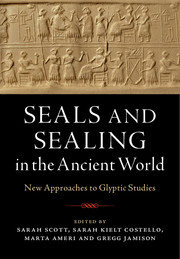 Seals and Sealing in the Ancient World
Seals and Sealing in the Ancient World Book contents
- Seals and Sealing in the Ancient World
- Seals and Sealing in the Ancient World
- Copyright page
- Contents
- Notes on Contributors
- Illustrations
- Plates
- Tables
- Acknowledgments
- Preface
- Abbreviations
- Chapter One Introduction: Small Windows, Wide Views
- Part I The Ancient Near East and Cyprus
- Part II South Asia and the Gulf Region
- Part III Egypt
- Part IV Aegean
- Chapter Eighteen Introductory Remarks, Aegean
- Chapter Nineteen Aegean Bronze Age Seal Stones and Finger Rings: Chronology and Functions
- Chapter Twenty An Aegean Seal in Greek Hands? Thoughts on the Perception of Aegean Seals in the Iron Age
- Chapter Twenty One Cryptic Glyptic: Multivalency in Minoan Glyptic Imagery
- Chapter Twenty Two The Magic and the Mundane: The Function of “Talismanic-Class” Stones in Minoan Crete
- References
- Endnotes
- Index
Chapter Twenty One - Cryptic Glyptic: Multivalency in Minoan Glyptic Imagery
from Part IV - Aegean
Published online by Cambridge University Press: 24 April 2018
- Seals and Sealing in the Ancient World
- Seals and Sealing in the Ancient World
- Copyright page
- Contents
- Notes on Contributors
- Illustrations
- Plates
- Tables
- Acknowledgments
- Preface
- Abbreviations
- Chapter One Introduction: Small Windows, Wide Views
- Part I The Ancient Near East and Cyprus
- Part II South Asia and the Gulf Region
- Part III Egypt
- Part IV Aegean
- Chapter Eighteen Introductory Remarks, Aegean
- Chapter Nineteen Aegean Bronze Age Seal Stones and Finger Rings: Chronology and Functions
- Chapter Twenty An Aegean Seal in Greek Hands? Thoughts on the Perception of Aegean Seals in the Iron Age
- Chapter Twenty One Cryptic Glyptic: Multivalency in Minoan Glyptic Imagery
- Chapter Twenty Two The Magic and the Mundane: The Function of “Talismanic-Class” Stones in Minoan Crete
- References
- Endnotes
- Index
Summary
Minoan glyptic imagery has been described as problematically ambiguous and has produced conflicting interpretations in scholarship. This chapter demonstrates how categorical classification of glyptic imagery reflects Western taxonomic structures, clustering image identification around central concepts, which both produces and marginalizes “ambiguous” imagery. This way of organizing knowledge conflicts with the fluidity of glyptic images. When organized as networks – rather than categories – of imagery, the “ambiguity” of Minoan glyptic is repositioned as multivalency, where multiple images can be elicited through a single, condensed form that draws on a network of comparanda. This condensed expression is both produced and supported by the physical properties of the glyptic medium, for example, Minoan lentoid and amygdaloid stamp seals can have ambiguous orientation, a quality that can be used to produce multiple images in different orientations. This is supported by the abbreviated forms used in glyptic imagery, which, owing to the lack of specificity through the omission of fine detail, can be readily fused into multivalent images. To situate this discussion within a wider context, this chapter briefly surveys other instances in which multivalent and ambiguous images have been created for a specific purpose, highlighting the possibility that Neopalatial Minoan seal engravers deliberately produced multivalent imagery in glyptic.
- Type
- Chapter
- Information
- Seals and Sealing in the Ancient WorldCase Studies from the Near East, Egypt, the Aegean, and South Asia, pp. 368 - 386Publisher: Cambridge University PressPrint publication year: 2018


